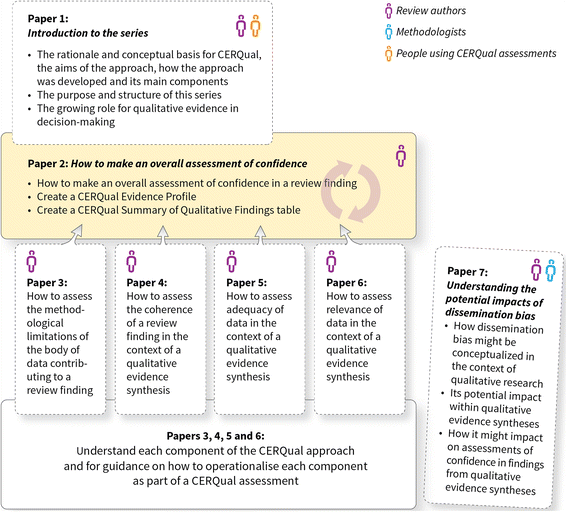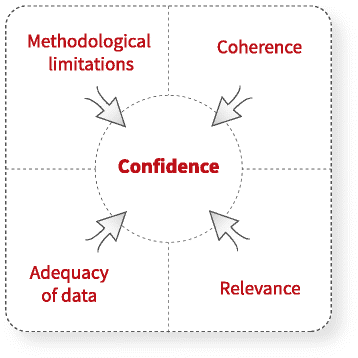Applying GRADE-CERQual to qualitative evidence synthesis findings-paper 2: how to make an overall CERQual assessment of confidence and create a Summary of Qualitative Findings table
- PMID: 29384082
- PMCID: PMC5791047
- DOI: 10.1186/s13012-017-0689-2
Applying GRADE-CERQual to qualitative evidence synthesis findings-paper 2: how to make an overall CERQual assessment of confidence and create a Summary of Qualitative Findings table
Abstract
Background: The GRADE-CERQual (Confidence in Evidence from Reviews of Qualitative research) approach has been developed by the GRADE (Grading of Recommendations Assessment, Development and Evaluation) Working Group. The approach has been developed to support the use of findings from qualitative evidence syntheses in decision making, including guideline development and policy formulation. CERQual includes four components for assessing how much confidence to place in findings from reviews of qualitative research (also referred to as qualitative evidence syntheses): (1) methodological limitations, (2) coherence, (3) adequacy of data and (4) relevance. This paper is part of a series providing guidance on how to apply CERQual and focuses on making an overall assessment of confidence in a review finding and creating a CERQual Evidence Profile and a CERQual Summary of Qualitative Findings table.
Methods: We developed this guidance by examining the methods used by other GRADE approaches, gathering feedback from relevant research communities and developing consensus through project group meetings. We then piloted the guidance on several qualitative evidence syntheses before agreeing on the approach.
Results: Confidence in the evidence is an assessment of the extent to which a review finding is a reasonable representation of the phenomenon of interest. Creating a summary of each review finding and deciding whether or not CERQual should be used are important steps prior to assessing confidence. Confidence should be assessed for each review finding individually, based on the judgements made for each of the four CERQual components. Four levels are used to describe the overall assessment of confidence: high, moderate, low or very low. The overall CERQual assessment for each review finding should be explained in a CERQual Evidence Profile and Summary of Qualitative Findings table.
Conclusions: Structuring and summarising review findings, assessing confidence in those findings using CERQual and creating a CERQual Evidence Profile and Summary of Qualitative Findings table should be essential components of undertaking qualitative evidence syntheses. This paper describes the end point of a CERQual assessment and should be read in conjunction with the other papers in the series that provide information on assessing individual CERQual components.
Keywords: Confidence; Evidence-based practice; GRADE; Guidance; Methodology; Qualitative evidence synthesis; Qualitative research; Research design; Systematic review methodology.
Conflict of interest statement
Ethics approval and consent to participate
Not applicable. This study did not undertake any formal data collection involving any humans or animals.
Consent for publication
Not applicable.
Competing interests
The authors declare that they have no competing interests.
Figures
Similar articles
-
Applying GRADE-CERQual to qualitative evidence synthesis findings-paper 3: how to assess methodological limitations.Implement Sci. 2018 Jan 25;13(Suppl 1):9. doi: 10.1186/s13012-017-0690-9. Implement Sci. 2018. PMID: 29384078 Free PMC article.
-
Applying GRADE-CERQual to qualitative evidence synthesis findings: introduction to the series.Implement Sci. 2018 Jan 25;13(Suppl 1):2. doi: 10.1186/s13012-017-0688-3. Implement Sci. 2018. PMID: 29384079 Free PMC article.
-
Applying GRADE-CERQual to qualitative evidence synthesis findings-paper 5: how to assess adequacy of data.Implement Sci. 2018 Jan 25;13(Suppl 1):14. doi: 10.1186/s13012-017-0692-7. Implement Sci. 2018. PMID: 29384077 Free PMC article.
-
Folic acid supplementation and malaria susceptibility and severity among people taking antifolate antimalarial drugs in endemic areas.Cochrane Database Syst Rev. 2022 Feb 1;2(2022):CD014217. doi: 10.1002/14651858.CD014217. Cochrane Database Syst Rev. 2022. PMID: 36321557 Free PMC article.
-
Factors that impact on recruitment to randomised trials in health care: a qualitative evidence synthesis.Cochrane Database Syst Rev. 2020 Oct 7;10(10):MR000045. doi: 10.1002/14651858.MR000045.pub2. Cochrane Database Syst Rev. 2020. PMID: 33026107 Free PMC article.
Cited by
-
Predictors, barriers, and facilitators to refugee women's employment and economic inclusion: A mixed methods systematic review.PLoS One. 2024 Jul 17;19(7):e0305463. doi: 10.1371/journal.pone.0305463. eCollection 2024. PLoS One. 2024. PMID: 39018302 Free PMC article.
-
Evaluating the impact of the global evidence, local adaptation (GELA) project for enhancing evidence-informed guideline recommendations for newborn and young child health in three African countries: a mixed-methods protocol.Health Res Policy Syst. 2024 Aug 19;22(1):114. doi: 10.1186/s12961-024-01189-5. Health Res Policy Syst. 2024. PMID: 39160559 Free PMC article.
-
Disclosing Child Sexual Abuse to a Health Professional: A Metasynthesis.Front Psychiatry. 2022 Jun 3;13:788123. doi: 10.3389/fpsyt.2022.788123. eCollection 2022. Front Psychiatry. 2022. PMID: 35747100 Free PMC article.
-
Synthesising evidence on patient portals: a protocol for an umbrella review.BMJ Open. 2019 Mar 30;9(3):e024469. doi: 10.1136/bmjopen-2018-024469. BMJ Open. 2019. PMID: 30928933 Free PMC article.
-
Sand Play for 0-8-Year-Old Children's Health and Development: A Systematic Review Protocol.Int J Environ Res Public Health. 2021 Sep 26;18(19):10112. doi: 10.3390/ijerph181910112. Int J Environ Res Public Health. 2021. PMID: 34639414 Free PMC article.
References
-
- Lewin S, Glenton C, Munthe-Kaas H, Carlsen B, Colvin CJ, Gulmezoglu M, Noyes J, Booth A, Garside R, Rashidian A. Using qualitative evidence in decision making for health and social interventions: an approach to assess confidence in findings from qualitative evidence syntheses (GRADE-CERQual) PLoS Med. 2015;12(10):e1001895. doi: 10.1371/journal.pmed.1001895. - DOI - PMC - PubMed
-
- Munthe-Kaas HM, Bohren M, Carlsen B, Glenton C, Lewin S, Colvin CJ, Tuncalp Ö, Noyes J, Booth A, Garside R, et al. Applying GRADE-CERQual to qualitative evidence synthesis findings—paper 3: how to assess methodological limitations. Implement Sci. 2018;13(Suppl 1): 10.1186/s13012-017-0690-9. - PMC - PubMed
Publication types
MeSH terms
Grants and funding
LinkOut - more resources
Full Text Sources
Other Literature Sources



